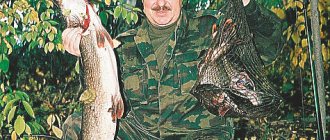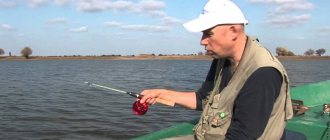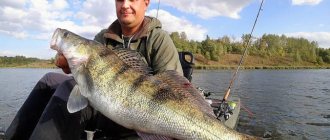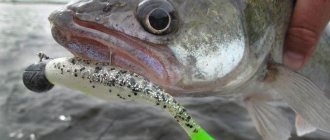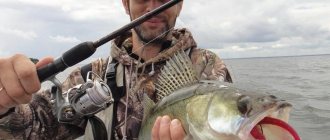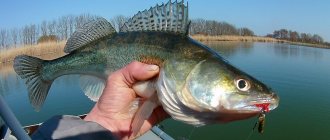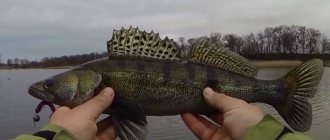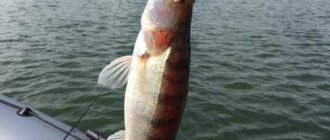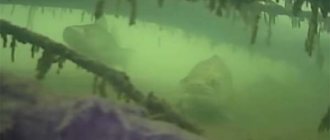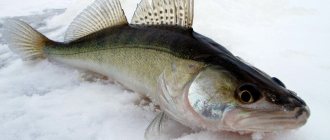Features of the method
Plumb fishing from a boat It is believed that this method is the easiest to implement and the most affordable in terms of financial costs.
To fish vertically, all you have to do is swim to the depths, cast a fishing rod, and you can make the fishing rod yourself. For vertical fishing, it is important to determine the fishing spots of the reservoir. It is worth noting that much in this case depends on weather conditions. For this method, the direction of the current and the wind are ideal - this helps to speed up and increase the chances of catching a lot of fish.
Too fast a current, coupled with wind, can negatively affect the quality of fishing. If the boat is carried along, then the bait “stretches” far behind, the line bends in an arc, which leads to disruption of contact with the tackle. Thus, it becomes impossible to control the bottom while fishing, as well as to feel the bite. However, there is a way out of this situation - a heavy sinker will save the situation. It can be thrown into the water to “brake” the boat.
You can fish from a boat with no more than two fishing rods. When you notice a bite, it is important to hook correctly. Choosing the right moment depends on the bait used and the type of fish.
in spring
When the water warms up to +10 – +15 degrees, the spawning time for pike perch begins. This is manifested in the fact that it begins to search for heated places with a rough bottom, where it subsequently lays eggs. At the end of this procedure, the pike perch goes to rest; it is inactive for 2 weeks. During this time, he will become very hungry, so after resting, he begins to eat vigorously, moving from one zone to another.
[THERE IS AN ANSWER] How to catch pike perch in March from the ice
During this period of time, catching pike perch with live bait in the spring can be done both from a boat and from the shore, using various gear that are made specifically for catching the predator. It is well caught both from the shore and from a boat, quickly attacking a variety of baits, including live bait. This does not last long, then the activity of the pike perch becomes less and it moves to depth. At this time, he hunts only at night.
.
The calm life of pike perch begins somewhere in early June, and it begins spawning in mid-April or early May. Without exception, everything depends on natural circumstances and how quickly the water heats up.
Live bait with a wide body, for example, crucian carp, rudd, and bream are not suitable. We choose a fish with a length of 7 to 10 cm.
Types of vertical fishing
Plumb fishing with a spinner
A rod for vertical trolling should be relatively short, with a rigid tip - about 50-150 cm in length. From the shore, they fish vertically with ordinary rods, with an elastic end, up to 5 m long. It is best to fish with a reel, but of course you can do without it (if you fish along the reach at a relatively flat depth). The strength of the fishing line itself must directly correspond to the size of the fish being caught, as well as the weight of the bait. A heavy spinner should not be tied to a thin line, and vice versa, a light spinner should not be tied to a thick line. A fishing line made of any good material will do, but it is advisable to use a vein line with a diameter of 0.25-030 mm. A steel leash is used only when the object being fished is a pike.
For vertical fishing, spoons are cut out of non-ferrous metals or cast from tin, then equipped with a triple, double or single hook with red wool. These lures are very similar in shape to winter lures. Length from 1.5 to 7 cm. In the part of the spoon closer to the hook, they are heavier.
If fishing occurs from the stern of the boat, then you need to hold an oar in one hand, guiding the boat with the current, therefore, in the other hand - a rod with a spoon, which is lowered vertically to the very bottom. All the time you need to shake the spoon slightly, lowering it and lifting it to the bottom.
Plumb fishing with a float
The shape, size and degree of immersion of the float are determined depending on the fishing conditions, the strength of the current, the depth, the habits of the fish and the state of the water surface. Lightweight cork or foam floats, spindle-shaped, as well as bow and feather floats are best suited.
They are very clearly visible on the surface of the water, quite sensitive and, when cast correctly, fall onto the water with virtually no unnecessary noise. In turn, the size of the float must correspond to the weight of the sinker and nozzle. It should be noted that the smaller the float, the lighter the weight needed to immerse it. In some cases, for example, when fishing for whitebait, there must be a more lifting float and a much heavier sinker. When fishing with live bait, you need to launch it 15-20 centimeters from the very bottom. When hooked with a nozzle, it sinks closer to the bottom (after checking with a depth gauge). When fishing among significant aquatic vegetation, the nozzle should be raised a little higher to a half-water position.
Catching bersh with silicone baits
When fishing with silicone baits, jig wiring is most effective. This method of fishing requires a sensitive nod and a braided fishing line. Bersh bites on twisters and worms can be quite gentle. Considering the depth of fishing, a weak bite may not be reflected on the hard tip.
Often, after the first and not very obvious bite, the tip freezes. At this time, the bersh stands motionless with the bait in its mouth. At this moment you should make a sharp cut. It is better to perform a wrist whipping movement, and the probability of a successful hook will be high. You should always remember that bersh, like pike perch, has a hard mouth. Therefore, hooks must always be sharp. There is no need to be afraid to overdo it with hooking.
In general, if you find the right place, then, as a rule, pike and perch bites first, and then bersh. First small and then larger pike perch may come to the point. It is enough to fish a point for 15-20 minutes to understand whether there is bersh here. Pay attention to the echo sounder readings. If there are fish on the screen, you can catch them. Bersh is not particularly picky. If it were in sufficient quantity, it would be no more difficult to catch than perch.
Be sure to select silicones based on their hardness and catchability. You will also need a certain supply of sinkers and jig heads. If the bersh takes well, then it is better to use twisters and worms made of hard silicone. Even if a predator bites off the tails, it’s okay. You can continue fishing.
If you have to fish in snags, you can use foam fish. They imitate the movements of fry well; after jerking, they hover a little and hover in the water column. On the one hand, such baits are catchy, and on the other hand, you don’t mind losing them because of their cheapness. You can make these fish yourself and paint them gray with red elements.
Bersh usually bite well in sunny weather. On such days, the bersh takes greedily and pulls the tackle with force. Sometimes it seems that there is a good pike perch on the other end, although in fact it is a bersh weighing up to 500 grams.
If you manage to pick up one specimen from one place, then you have a good chance of catching a couple more. When a flock of bershes approaches, the bites follow one after another. Some experienced fishermen have several such purely pike perch and bersh places on their secret list. The bites on them follow one after another. When fishing like this, you don’t mind losing your bait. Fishing takes place at a high pace, you have to work hard and there is absolutely no time even for food, not to mention other things.
What places are we talking about? First of all, with a depth of 10 meters or more. There are a lot of snags and stones at the bottom. If you put the bait on the bottom, the number of hooks will be very large. At the beginning of fishing, we use a weight to break through a relatively clean area among the snags. We remember where to throw and carefully perform vertical wiring with jerks. Yes, the number of annoying cliffs will not please you, but the number of bites and fish caught will fully compensate for the losses.
On cloudy and rainy days, you have to sort through the baits for a long time until you can find the most catchy one. But even in such weather, fishing in such places is very effective. If the bersh's bite is not so active, try flavoring the bait with fish and shrimp attractants. This applies to both foam rubber and silicone rubber. You just need to apply a few drops and the bait will be saturated.
You can also catch bersh on quiet summer nights. At this time, it is very effective to use equipment with a retractable leash. You can put slugs or long crawling worms on the hook. You can fish like a donkey. Just throw the tackle to the desired place, and attach a firefly to the tip. Now on sale there are fireflies with a plastic mount of this type:
They are convenient to attach to the thinnest tips.
Tackle for vertical fishing
Tackle for vertical fishing is made with the expectation of a hanging position of the hook on the fishing line. The degree of immersion of the float, its size and shape are determined depending on the fishing conditions: depth, current strength, state of the water surface and the habits of the fish that are going to be caught.
The most convenient are light, spindle-shaped, cork or foam floats, as well as feather and box floats. They are clearly visible on the surface of the water, sensitive and, with skillful casting, fall onto the water without making noise. The size of the float corresponds to the weight of the sinker and bait. The smaller the float, the lighter the sinker needed to sink it should be, and the more sensitive the entire tackle as a whole. When fishing among aquatic vegetation, the bait usually rises to the half-water position.
You can make a tackle with two hooks and use different attachments. Then the second hook is attached to the main fishing line on a separate leash 10 - 20 cm long below or above the sinker. When fishing with one hook, the sinker is attached 15 - 25 cm from the hook. When fishing in reservoirs abounding in bleak, choose a larger float and a heavier sinker so that the hook with the bait goes to the bottom faster, otherwise the greedy little thing will have time to eat the slowly sinking bait.
Places for autumn fishing for pike perch
From the beginning of autumn until freeze-up, pike perch gradually slides into deep holes, where the main food for the predator - small fish - is abundant. Near these wintering holes, autumn fishing for pike perch can be very successful. Searches for accumulations of small things are best done using an echo sounder, and in its absence, based on information about such places extracted from the “aboriginal spinners”.
Plumb fishing tactics
When catching predatory fish vertically from a watercraft, you should adhere to some fishing tactics. Experienced fishing anglers recommend using two main fishing methods.
- The simplest, but quite effective option for vertical trolling is fishing at changes in depth. If you have an echo sounder, fishing will not be particularly difficult. First, the boat must be directed towards a noticeable difference in depth. Most often on the river, fish concentrate on the channel edges. That is why the watercraft must be forced to move directly above the depth difference. Periodically it is necessary to check the echo sounder readings. With each subsequent swim, it is possible to more accurately navigate promising areas, which increases the number of bites.
- When fishing takes place on a flat river, it is difficult to find a clearly defined edge. In this case, the prey is often located on a flat plateau. In this case, a different fishing tactic is used. It is better to drive the boat in a zigzag manner, especially when the wind direction is perpendicular to the movement of the water flow. This type of fishing can be called search.
Sheer fishing is interesting and exciting. At different times of the year, the predator can be located at a depth of 3 to 15 m. If you manage to find schooling fish, the catch will exceed the wildest expectations of a beginner. It is important that the tackle copes with the jerks of an impressive specimen, and that the angler does not make mistakes when fishing.
Choosing gear for vertical trolling
Tackle for catching pike perch with vertical lures must be durable, reliable and functional.
The fishing rod used is either a short and rigid side rod or a small spinning rod with guide rings. At the tip of the rod, be sure to install a small, sensitive nod made of a fairly elastic and stiff spring.
We also recommend reading:
Attractant for predatory fish: baits for pike perch, pike, perch Winter fishing for pike perch Catching pike perch in winter using jigs Catching pike perch in winter using girders
